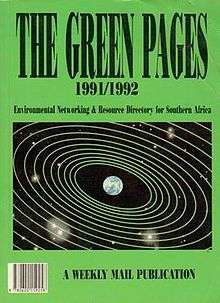Environmental movement in South Africa
| Environmental movement in South Africa |
|---|
| Organisations |
| Conferences |

The environmental movement in South Africa traces its history from the early beginnings of conservation, to the rise of radicalism and activism amongst local ecologists. Before the Chernobyl disaster and the fall of the Berlin Wall, there were very few green activist groups in the country. Koeberg Alert and the Dolphin Action and Protection Group are probably two of the oldest post-conservation groups.
While most early conservationists, with few exceptions, implicated themselves in the apartheid system, groups such as Earthlife Africa were consciously aware of their role as nurturers of freedom and human rights as well as the rights of the earth and animal kingdom. The Cape Town Ecology Group for example, openly campaigned for political freedoms with a platform that "ecologised politics and politicised ecology".[1]
During apartheid while political parties were banned, environmental groups served as an outlet for activism and political expression. In Durban, the Environmental Justice Network, sprung up alongside ant-apartheid issues that affected the environment as well as the rights of workers. While many radical environmentalists were later absorbed into the governing African National Congress, some toyed with the formation of a political party that would represent green interests.
Timeline
Apartheid Era
- 1926: Wildlife Society of South Africa founded;
- 1973: Endangered Wildlife Trust founded;
- 1977: The Dolphin Action & Protection Group founded with the motto and policy that 'DOLPHINS SHOULD BE FREE'.
- 1983: Koeberg Alert founded;
- 1986: Chernobyl disaster
- 1987: Cape Town Ecology Group founded; with motto: 'FREE THE HUMANS'
- 1988: Earthlife Africa formed;
- 1989: Earthlife Africa exposes mercury poisoning of workers at Thor Chemicals;[2] Kagenna Magazine is published
- 1990: A fishing industry campaign by the Food and Allied Workers Union links workers issues to the environment;
- 1991: First National Conference on Environment and Development; Environmental Monitoring Group releases a document "Towards Sustainable Development in South Africa";[3] General Magnus Malan takes over as new Minister of Water Affairs and Forestry; Bev Geach of the Weekly Mail publishes The Green Pages, a directory of environmental groups
- 1992: Earthlife Africa pressurizes the government for an inquiry into asbestos related deaths. Environmental Justice Networking Forum (EJNF) formed at an ELA conference.
- 1993: Group for Environmental Monitoring (GEM) founded.
Post-Apartheid Era
- 1994: After South Africa's first democratic election, environmental rights submitted for debate to the Constitutional Assembly.
- 1995: eThekwini ECOPEACE founded
- 1996: South Africa's Bill of Rights proclaims: "Everyone has the right to an environment that is not harmful to their health or well-being."
- 1997: The ANC government moves to provide lead-free petrol as one of its first pro-environment policies
- 1998: The Truth Commission hears about asbestos-related deaths from mining
- 1999: Groundwork (GW), a non-profit, environmental justice service and development organization founded by 3 ex-EJNF activists
- 2000: South Durban Community Environmental Alliance (SDCEA)formed; eThekwini ECOPEACE wins one seat in the eThekwini Municipal Council, the first time a Green Party of any sort in South Africa has won at the polls
- 2002: Rio+10 World Summit on Sustainable Development held in Johannesburg; Earthlife launches the People’s Environmental Centre, the Greenhouse.
- 2003: Asbestos Relief Trust (ART) set up, and the Kgalagadi Relief Trust (KRT), both of which evaluate claims and provide compensation for qualified claimants. A media statement, indicates that the ban on the use of asbestos and asbestos-related materials was "well overdue." National Energy Caucus founded.
- 2004: Marthinus van Schalkwyk appointed as Minister of Environmental Affairs and Tourism
- 2006: Eskom, South Africa's national energy utility issues energy-saving lightbulbs to consumers as part of a "demand-side" energy-reduction campaign.
- Dept of Environmental Affairs and Tourism holds hearings on nuclear power. First evidence of contamination and worker-related deaths caused b exposure to radiation.
- 2009: South Africa participates in the Copenhagen Climate Change round.
- 2010: SA Government announces mothballing of PBMR
- 2011: South Africa hosts COP17 in Durban, a new framework emerges.
- 2015: South Africa hosts South African International Renewable Energy Conference.
See also
References
- ↑ Lewis, D R, "Ending the Apartheid of the Environment", South, Southside Environment, 7–13 March 1991, p19
- ↑ http://www.umich.edu/~snre492/Jones/thorchem.htm
- ↑ Lewis, D R, "Environment and Economics go together?", South Environment, Sept 19-25, 1991, p20